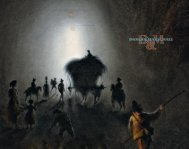Catalogue 2010 - daxer & marschall
Catalogue 2010 - daxer & marschall
Catalogue 2010 - daxer & marschall
You also want an ePaper? Increase the reach of your titles
YUMPU automatically turns print PDFs into web optimized ePapers that Google loves.
JAMES JACquES JOSEPH TISSOT<br />
The Kitchen Garden<br />
James Jacques Joseph Tissot<br />
(Nantes 1836 - 1902 Buillon)<br />
The Kitchen Garden<br />
Oil on cardboard<br />
Verso inscribed vente Tissot<br />
1907 [3]<br />
32 x 40 cm<br />
Provenance:<br />
Studio sale of the artist, Paris,<br />
Hôtel Drouot, 1903<br />
On the back of this picture is an inscription identifying it as ‘James Tissot / Le Presbyterre [sic] / signé<br />
à gauche’. Further inscriptions give details of sales, including ‘Vendu à l’Hotel Drouot / Vente Tissot<br />
(James) / en 1907’. Tissot’s Paris studio sale in fact took place in 1903, on 9-10 July. Lot number<br />
20 comprised ‘les Études croquis et dessins’ and there were further lots of various items not listed in<br />
the printed catalogue, according to a copy with pencil annotations in a French library. Many of<br />
these sketches and drawings were bought by an artist friend of Tissot, Xavier Desparmet-Fitzgerald,<br />
but other purchasers are unknown. Additional studies that remained at Tissot’s country house, the<br />
Château de Buillon near Besançon, were dispersed through auction in 1968 following the death<br />
of Tissot’ niece, Jeanne. These various sketches included ones in oil paints on card or board, some<br />
of them ‘on the spot’ studies, such as that of Richmond Bridge (Sotheby’s, London, 15 June 1999,<br />
lot 46, withdrawn). No trace of a signature is now evident on Le Presbytère but a number of elements<br />
support an attribution to Tissot.<br />
Jacques Joseph Tissot (1836-1902), who called himself James from at least the time he began<br />
art studies in Paris, lived and worked in the French capital from 1855 to 1871, then again from late<br />
1882 until his death. From mid-1871 until late 1882 he lived in London, but visited the city from time<br />
to time both before and after that period. He also travelled across the country to places as far apart<br />
as Glasgow, Brighton, Manchester and Newcastle, at the invitation of dealers, exhibition organisers<br />
and patrons, to view exhibitions where his work was shown or to make studies for portraits. Other<br />
visits Tissot made for sketching purposes included trips up the Thames to Twickenham, Richmond<br />
and Oxford, and rail or steamer trips to the south coast. The location and identity of the church and<br />
parsonage in Le Presbytère are unknown but the church architecture is English fourteenth century,<br />
according to Professor Paul Crossley, the medieval specialist at the Courtauld Institute of Art. The<br />
distant tower of a castle or church on the left might help identify the location. Tissot was a Roman<br />
Catholic and regular Mass attender but there were few Catholic churches in England as Roman<br />
Catholics had been banned from practising their religion for three centuries.<br />
The artist’s caricatures for Vanity Fair magazine included Anglican clergymen but little is<br />
known about the extent of his social circle, or individual friends and acquaintances, other than fellow<br />
artists. It is probable that Tissot was friendly with a broad range of Anglicans as well as Catholics,<br />
since he did not become overtly religious until after his visit to the Holy Land in 1886, when he<br />
became very devout and focused on the illustration of the life of Christ then of the Old Testament.<br />
Two of the things that Tissot most admired in England were English buildings and gardens.<br />
His house in Paris, at the end of the very fashionable newly constructed Avenue de l’Impératrice<br />
(now Avenue Foch) near the Bois de Boulogne, was ‘an English-style villa’ set in a small garden.<br />
When he decided to settle in London, because his work was selling much faster and for higher sums<br />
than it had in Paris, Tissot bought the leasehold of a queen Anne-style villa in St John’s Wood, built<br />
of red brick with white stone dressing and having a large garden. He added a huge conservatory for<br />
exotic plants, extending from a new studio, and laid out the garden with formal English-style colour<br />
beds and areas of more informal ‘romantic’ planting such as he was familiar with from French<br />
parks. There were kitchen gardens too, and existing greenhouses expanded for fruit and vegetables<br />
as well as flowers. The contrast of red brick and green vegetation seen in Le Presbytère, with its<br />
65






